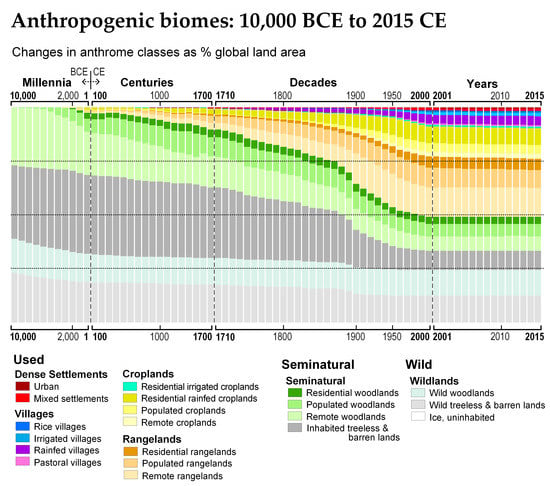Anthropogenic Biomes: 10,000 BCE to 2015 CE
Abstract
1. Introduction
2. Methods
2.1. Land Use and Population Data (HYDE 3.2)
2.2. Anthrome Classification and Mapping
2.3. Statistical Assessments and Map Comparisons
3. Results
3.1. Comparison wth Prior Anthrome Maps
3.2. Anthrome Changes 10,000 BCE to 2015 CE
4. Discussion
4.1. Comparing Anthromes 12K with Anthromes 2.0
4.1.1. General Improvements in Land Use and Other Inputs
4.1.2. Pastures and Rangelands
4.1.3. Woodlands
4.2. Long-Term Changes in Anthromes
4.3. Applications of Anthromes 12K
5. Conclusions
Supplementary Materials
Author Contributions
Funding
Acknowledgments
Conflicts of Interest
Appendix A
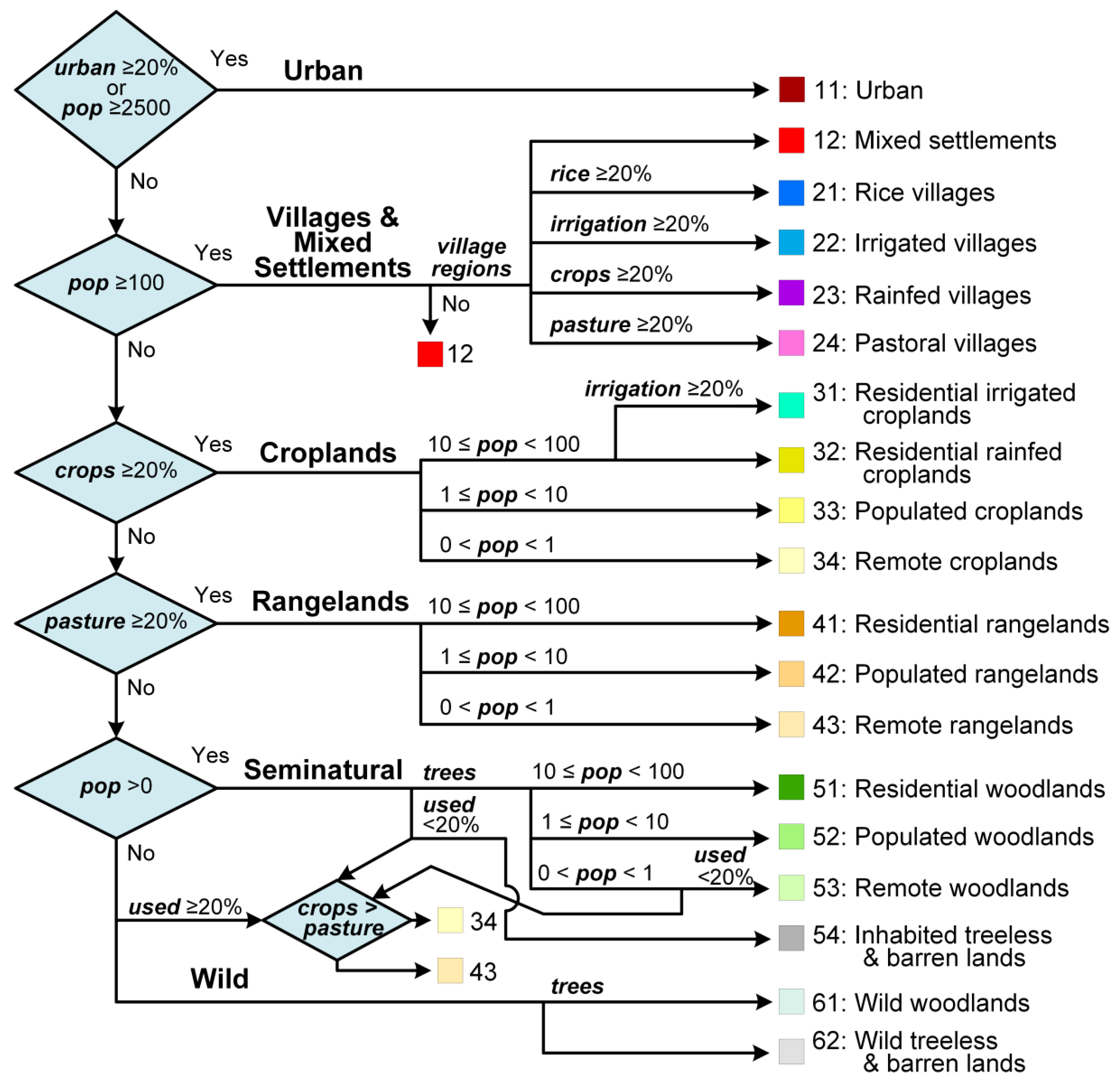
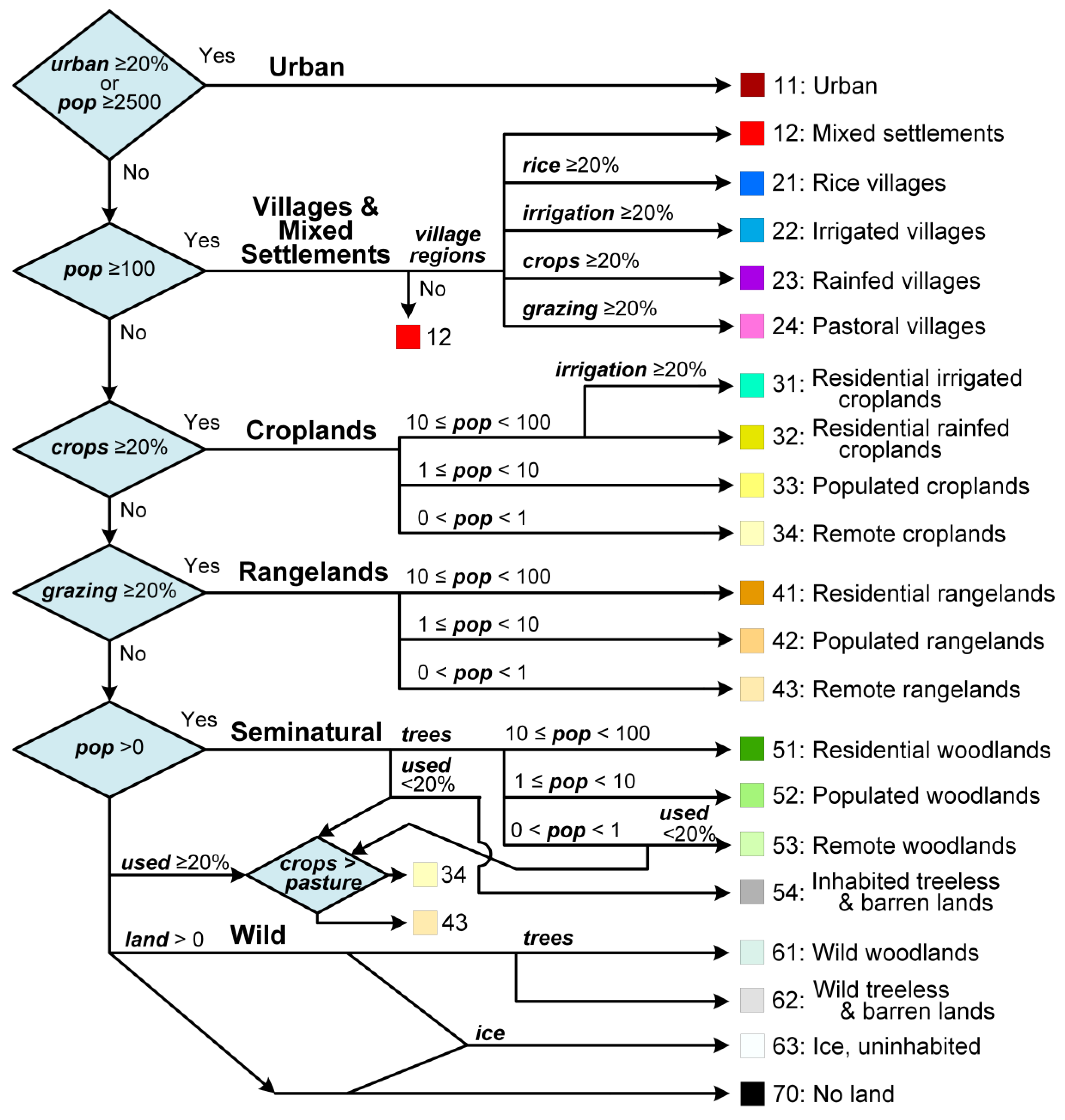
References
- Newbold, T.; Hudson, L.N.; Hill, S.L.L.; Contu, S.; Lysenko, I.; Senior, R.A.; Borger, L.; Bennett, D.J.; Choimes, A.; Collen, B.; et al. Global effects of land use on local terrestrial biodiversity. Nature 2015, 520, 45–50. [Google Scholar] [CrossRef] [PubMed]
- Foley, J.A.; DeFries, R.; Asner, G.P.; Barford, C.; Bonan, G.; Carpenter, S.R.; Chapin, F.S.; Coe, M.T.; Daily, G.C.; Gibbs, H.K.; et al. Global consequences of land use. Science 2005, 309, 570–574. [Google Scholar] [CrossRef] [PubMed]
- Steffen, W.; Broadgate, W.; Deutsch, L.; Gaffney, O.; Ludwig, C. The trajectory of the anthropocene: The great acceleration. Anthr. Rev. 2015, 2, 81–98. [Google Scholar] [CrossRef]
- Lewis, S.L.; Maslin, M.A. Defining the anthropocene. Nature 2015, 519, 171–180. [Google Scholar] [CrossRef] [PubMed]
- Hurtt, G.; Chini, L.; Frolking, S.; Betts, R.; Feddema, J.; Fischer, G.; Fisk, J.; Hibbard, K.; Houghton, R.; Janetos, A.; et al. Harmonization of land-use scenarios for the period 1500–2100: 600 years of global gridded annual land-use transitions, wood harvest, and resulting secondary lands. Clim. Chang. 2011, 109, 117–161. [Google Scholar] [CrossRef]
- Ellis, E.C. Anthropogenic transformation of the terrestrial biosphere. Proc. R. Soc. A: Math. Phys. Eng. Sci. 2011, 369, 1010–1035. [Google Scholar] [CrossRef]
- Waters, C.N.; Zalasiewicz, J.; Summerhayes, C.; Barnosky, A.D.; Poirier, C.; Gałuszka, A.; Cearreta, A.; Edgeworth, M.; Ellis, E.C.; Ellis, M.; et al. The anthropocene is functionally and stratigraphically distinct from the holocene. Science 2016, 351, aad2622. [Google Scholar] [CrossRef]
- Ellis, E.C.; Kaplan, J.O.; Fuller, D.Q.; Vavrus, S.; Klein Goldewijk, K.; Verburg, P.H. Used planet: A global history. Proc. Natl. Acad. Sci. USA 2013, 110, 7978–7985. [Google Scholar] [CrossRef]
- Ellis, E.C. Ecology in an anthropogenic biosphere. Ecol. Monogr. 2015, 85, 287–331. [Google Scholar] [CrossRef]
- Smith, B.D.; Zeder, M.A. The onset of the anthropocene. Anthropocene 2013, 4, 8–13. [Google Scholar] [CrossRef]
- Kirch, P.V. Archaeology and global change: The holocene record. Annu. Rev. Environ. Resour. 2005, 30, 409. [Google Scholar] [CrossRef]
- Stephens, L.; Fuller, D.; Boivin, N.; Rick, T.; Gauthier, N.; Kay, A.; Marwick, B.; Geralda, C.; Armstrong, D.; Barton, C.M.; et al. Archaeological assessment reveals earth’s early transformation through land use. Science 2019, 365, 897–902. [Google Scholar] [CrossRef] [PubMed]
- Doughty, C.E. Preindustrial human impacts on global and regional environment. Annu. Rev. Environ. Resour. 2013, 38, 503–527. [Google Scholar] [CrossRef]
- Ruddiman, W.F.; Fuller, D.Q.; Kutzbach, J.E.; Tzedakis, P.C.; Kaplan, J.O.; Ellis, E.C.; Vavrus, S.J.; Roberts, C.N.; Fyfe, R.; He, F.; et al. Late holocene climate: Natural or anthropogenic? Rev. Geophys. 2016, 54, 93–118. [Google Scholar] [CrossRef]
- Kaplan, J.O.; Krumhardt, K.M.; Ellis, E.C.; Ruddiman, W.F.; Lemmen, C.; Klein Goldewijk, K. Holocene carbon emissions as a result of anthropogenic land cover change. Holocene 2011, 21, 775–791. [Google Scholar] [CrossRef]
- Ramankutty, N.; Foley, J.A. Estimating historical changes in global land cover: Croplands from 1700 to 1992. Glob. Biogeochem. Cycles 1999, 13, 997–1027. [Google Scholar] [CrossRef]
- Klein Goldewijk, K.; Beusen, A.; van Drecht, G.; de Vos, M. The hyde 3.1 spatially explicit database of human induced global land use change over the past 12,000 years. Glob. Ecol. Biogeogr. 2011, 20, 73–86. [Google Scholar] [CrossRef]
- Klein Goldewijk, K.; Beusen, A.; Janssen, P. Long-term dynamic modeling of global population and built-up area in a spatially explicit way: Hyde 3.1. Holocene 2010, 20, 565–573. [Google Scholar] [CrossRef]
- Klein Goldewijk, K. Estimating global land use change over the past 300 years: The hyde database. Glob. Biogeochem. Cycles 2001, 15, 417–433. [Google Scholar] [CrossRef]
- Pongratz, J.; Reick, C.; Raddatz, T.; Claussen, M. A reconstruction of global agricultural areas and land cover for the last millennium. Glob. Biogeochem. Cycles 2008, 22, GB3018. [Google Scholar] [CrossRef]
- Olofsson, J.; Hickler, T. Effects of human land-use on the global carbon cycle during the last 6,000 years. Veg. Hist. Archaeobotany 2008, 17, 605–615. [Google Scholar] [CrossRef]
- Sanderson, E.W.; Jaiteh, M.; Levy, M.A.; Redford, K.H.; Wannebo, A.V.; Woolmer, G. The human footprint and the last of the wild. Bioscience 2002, 52, 891–904. [Google Scholar] [CrossRef]
- Ellis, E.C.; Ramankutty, N. Putting people in the map: Anthropogenic biomes of the world. Front. Ecol. Environ. 2008, 6, 439–447. [Google Scholar] [CrossRef]
- Ellis, E.C.; Klein Goldewijk, K.; Siebert, S.; Lightman, D.; Ramankutty, N. Anthropogenic transformation of the biomes, 1700 to 2000. Glob. Ecol. Biogeogr. 2010, 19, 589–606. [Google Scholar] [CrossRef]
- National Geographic Society. National Geographic Atlas of the World, 10th ed.; National Geographic Society: Washington, DC, USA, 2014; p. 448. [Google Scholar]
- Freeman, S.; Quillin, K.; Allison, L.; Black, M.; Podgorski, G.; Taylor, E.; Carmichael, J. Biological Science, 6th ed.; Benjamin-Cummings Publishing Company: San Francisco, CA, USA, 2016; p. 1360. [Google Scholar]
- Smith, J.A.; Powell, L.A.; Brown, M.B. Training wildlife biologists for work in anthromes. In Reference Module in Earth Systems and Environmental Sciences; Elsevier: Amsterdam, The Netherlands, 2019. [Google Scholar]
- Dinerstein, E.; Olson, D.; Joshi, A.; Vynne, C.; Burgess, N.D.; Wikramanayake, E.; Hahn, N.; Palminteri, S.; Hedao, P.; Noss, R.; et al. An ecoregion-based approach to protecting half the terrestrial realm. Bioscience 2017, 67, 534–545. [Google Scholar] [CrossRef]
- Martin, L.J.; Quinn, J.E.; Ellis, E.C.; Shaw, M.R.; Dorning, M.A.; Hallett, L.M.; Heller, N.E.; Hobbs, R.J.; Kraft, C.E.; Law, E.; et al. Biodiversity conservation opportunities across the world’s anthromes. Divers. Distrib. 2014, 20, 745–755. [Google Scholar] [CrossRef]
- Miraldo, A.; Li, S.; Borregaard, M.K.; Flórez-Rodríguez, A.; Gopalakrishnan, S.; Rizvanovic, M.; Wang, Z.; Rahbek, C.; Marske, K.A.; Nogués-Bravo, D. An anthropocene map of genetic diversity. Science 2016, 353, 1532–1535. [Google Scholar] [CrossRef]
- Chapin, F.S., III; Matson, P.A.; Vitousek, P.M. Principles of Terrestrial Ecosystem Ecology, 2nd ed.; Springer: Berlin, Germany, 2012. [Google Scholar]
- Merritts, D.; Menking, K.; DeWet, A. Environmental Geology: An Earth Systems Approach, 2nd ed.; W. H. Freeman: New York, NY, USA, 2014; p. 604. [Google Scholar]
- He, F.; Vavrus, S.J.; Kutzbach, J.E.; Ruddiman, W.F.; Kaplan, J.O.; Krumhardt, K.M. Simulating global and local surface temperature changes due to holocene anthropogenic land cover change. Geophys. Res. Lett. 2014, 41, 623–631. [Google Scholar] [CrossRef]
- Lawrence, D.M.; Hurtt, G.C.; Arneth, A.; Brovkin, V.; Calvin, K.V.; Jones, A.D.; Jones, C.D.; Lawrence, P.J.; de Noblet-Ducoudré, N.; Pongratz, J.; et al. The land use model intercomparison project (lumip) contribution to cmip6: Rationale and experimental design. Geosci. Model Dev. 2016, 9, 2973–2998. [Google Scholar] [CrossRef]
- Klein Goldewijk, K.; Beusen, A.; Doelman, J.; Stehfest, E. Anthropogenic land use estimates for the holocene—hyde 3.2. Earth Syst. Sci. Data 2017, 9, 927–953. [Google Scholar] [CrossRef]
- Siebert, S.; Doll, P.; Feick, S.; Hoogeveen, J.; Frenken, K. Global Map of Irrigation Areas Version 4.0.1; Johann Wolfgang Goethe University: Frankfurt am Main, Germany, 2007. [Google Scholar]
- Monfreda, C.; Ramankutty, N.; Foley, J.A. Farming the planet: 2. Geographic distribution of crop areas, yields, physiological types, and net primary production in the year 2000. Glob. Biogeochem. Cycles 2008, 22, GB1022. [Google Scholar] [CrossRef]
- Prentice, I.C.; Cramer, W.; Harrison, S.P.; Leemans, R.; Monserud, R.A.; Solomon, A.M. A global biome model based on plant physiology and dominance, soil properties and climate. J. Biogeogr. 1992, 19, 117–134. [Google Scholar] [CrossRef]
- Visser, H.; de Nijs, T. The map comparison kit. Environ. Model. Softw. 2006, 21, 346–358. [Google Scholar] [CrossRef]
- Rees, W.G. Comparing the spatial content of thematic maps. Int. J. Remote Sens. 2008, 29, 3833–3844. [Google Scholar] [CrossRef]
- Rea, L.M.; Parker, R.A. Designing and Conducting Survey Research: A Comprehensive Guide; Jossey-Bass: San Francisco, CA, USA, 1997. [Google Scholar]
- Olson, D.M.; Dinerstein, E.; Wikramanayake, E.D.; Burgess, N.D.; Powell, G.V.N.; Underwood, E.C.; D’Amico, J.A.; Itoua, I.; Strand, H.E.; Morrison, J.C.; et al. Terrestrial ecoregions of the world: A new map of life on earth. Bioscience 2001, 51, 933–938. [Google Scholar] [CrossRef]
- Klein Goldewijk, K.; Dekker, S.C.; van Zanden, J.L. Per-capita estimations of long-term historical land use and the consequences for global change research. J. Land Use Sci. 2017, 12, 313–337. [Google Scholar] [CrossRef]
- Phelps, L.N.; Kaplan, J.O. Land use for animal production in global change studies: Defining and characterizing a framework. Glob. Chang. Biol. 2017, 23, 4457–4471. [Google Scholar] [CrossRef]
- Sayre, N.F.; Davis, D.K.; Bestelmeyer, B.; Williamson, J.C. Rangelands: Where anthromes meet their limits. Land 2017, 6, 31. [Google Scholar] [CrossRef]
- Chazdon, R.L.; Brancalion, P.H.S.; Laestadius, L.; Bennett-Curry, A.; Buckingham, K.; Kumar, C.; Moll-Rocek, J.; Vieira, I.C.G.; Wilson, S.J. When is a forest a forest? Forest concepts and definitions in the era of forest and landscape restoration. Ambio 2016, 45, 538–550. [Google Scholar] [CrossRef]
- Potapov, P.; Hansen, M.C.; Laestadius, L.; Turubanova, S.; Yaroshenko, A.; Thies, C.; Smith, W.; Zhuravleva, I.; Komarova, A.; Minnemeyer, S.; et al. The last frontiers of wilderness: Tracking loss of intact forest landscapes from 2000 to 2013. Sci. Adv. 2017, 3, e1600821. [Google Scholar] [CrossRef]
- Roberts, N. How humans changed the face of earth. Science 2019, 365, 865–866. [Google Scholar] [CrossRef] [PubMed]
- Klein Goldewijk, K.; Verburg, P.H. Uncertainties in global-scale reconstructions of historical land use: An illustration using the hyde data set. Landsc. Ecol. 2013, 28, 861–877. [Google Scholar] [CrossRef]
- Harrison, S.P.; Gaillard, M.J.; Stocker, B.D.; Vander Linden, M.; Klein Goldewijk, K.; Boles, O.; Braconnot, P.; Dawson, A.; Fluet-Chouinard, E.; Kaplan, J.O.; et al. Development and testing scenarios for implementing land use and land cover changes during the holocene in earth system model experiments. Geosci. Model Dev. 2020, 13, 805–824. [Google Scholar] [CrossRef]
- Gaillard, M.-J.; Morrison, K.D.; Madella, M.; Whitehouse, N. Past land-use and land-cover change: The challenge of quantification at the subcontinental to global scales. Pages Mag. 2018, 26, 3. [Google Scholar] [CrossRef]
- Smith, B.D. General patterns of niche construction and the management of ‘wild’ plant and animal resources by small-scale pre-industrial societies. Philos. Trans. R. Soc. B Biol. Sci. 2011, 366, 836–848. [Google Scholar] [CrossRef]
- Bliege Bird, R.; Nimmo, D. Restore the lost ecological functions of people. Nat. Ecol. Evol. 2018, 2, 1050–1052. [Google Scholar] [CrossRef]
- Pekin, B.K.; Pijanowski, B.C. Global land use intensity and the endangerment status of mammal species. Divers. Distrib. 2012, 18, 909–918. [Google Scholar] [CrossRef]
- Ellis, E.C.; Antill, E.C.; Kreft, H. All is not loss: Plant biodiversity in the anthropocene. PLoS ONE 2012, 7, e30535. [Google Scholar] [CrossRef]
- Rowan, J.; Beaudrot, L.; Franklin, J.; Reed, K.E.; Smail, I.E.; Zamora, A.; Kamilar, J.M. Geographically divergent evolutionary and ecological legacies shape mammal biodiversity in the global tropics and subtropics. Proc. Natl. Acad. Sci. USA 2020, 117, 1559–1565. [Google Scholar] [CrossRef]
- Mueller, T.; Dressler, G.; Tucker, C.; Pinzon, J.; Leimgruber, P.; Dubayah, R.; Hurtt, G.; Böhning-Gaese, K.; Fagan, W. Human land-use practices lead to global long-term increases in photosynthetic capacity. Remote Sens. 2014, 6, 5717. [Google Scholar] [CrossRef]
- Pereira, J.M.C.; Turkman, M.A.A.; Turkman, K.F.; Oom, D. Anthromes displaying evidence of weekly cycles in active fire data cover 70% of the global land surface. Sci. Rep. 2019, 9, 11424. [Google Scholar] [CrossRef] [PubMed]
- Ibisch, P.L.; Hoffmann, M.T.; Kreft, S.; Pe’er, G.; Kati, V.; Biber-Freudenberger, L.; DellaSala, D.A.; Vale, M.M.; Hobson, P.R.; Selva, N. A global map of roadless areas and their conservation status. Science 2016, 354, 1423–1427. [Google Scholar] [CrossRef]
- Garnett, S.; Fernández-Llamazares, Á.; Robinson, C.; Ellis, E.C.; Geyle, H.; Leiper, I.; Watson, J.; Fa, J.E.; Zander, K.; Jackson, M.V.; et al. Indigenous peoples are crucial for conservation—A quarter of all land is in their hands. The Conversation, 2018 17 July. [Google Scholar]
- Jacobson, A.P.; Riggio, J.; Tait, A.M.; Baillie, J.E. Global areas of low human impact (‘low impact areas’) and fragmentation of the natural world. Sci. Rep. 2019, 9, 14179. [Google Scholar] [CrossRef] [PubMed]
- Gibson, D.; Quinn, J. Application of anthromes to frame scenario planning for landscape-scale conservation decision making. Land 2017, 6, 33. [Google Scholar] [CrossRef]
- Brearley, G.; Rhodes, J.; Bradley, A.; Baxter, G.; Seabrook, L.; Lunney, D.; Liu, Y.; McAlpine, C. Wildlife disease prevalence in human-modified landscapes. Biol. Rev. 2013, 88, 427–442. [Google Scholar] [CrossRef] [PubMed]
- Martin, L.J.; Blossey, B.; Ellis, E. Mapping where ecologists work: Biases in the global distribution of terrestrial ecological observations. Front. Ecol. Environ. 2012, 10, 195–201. [Google Scholar] [CrossRef]
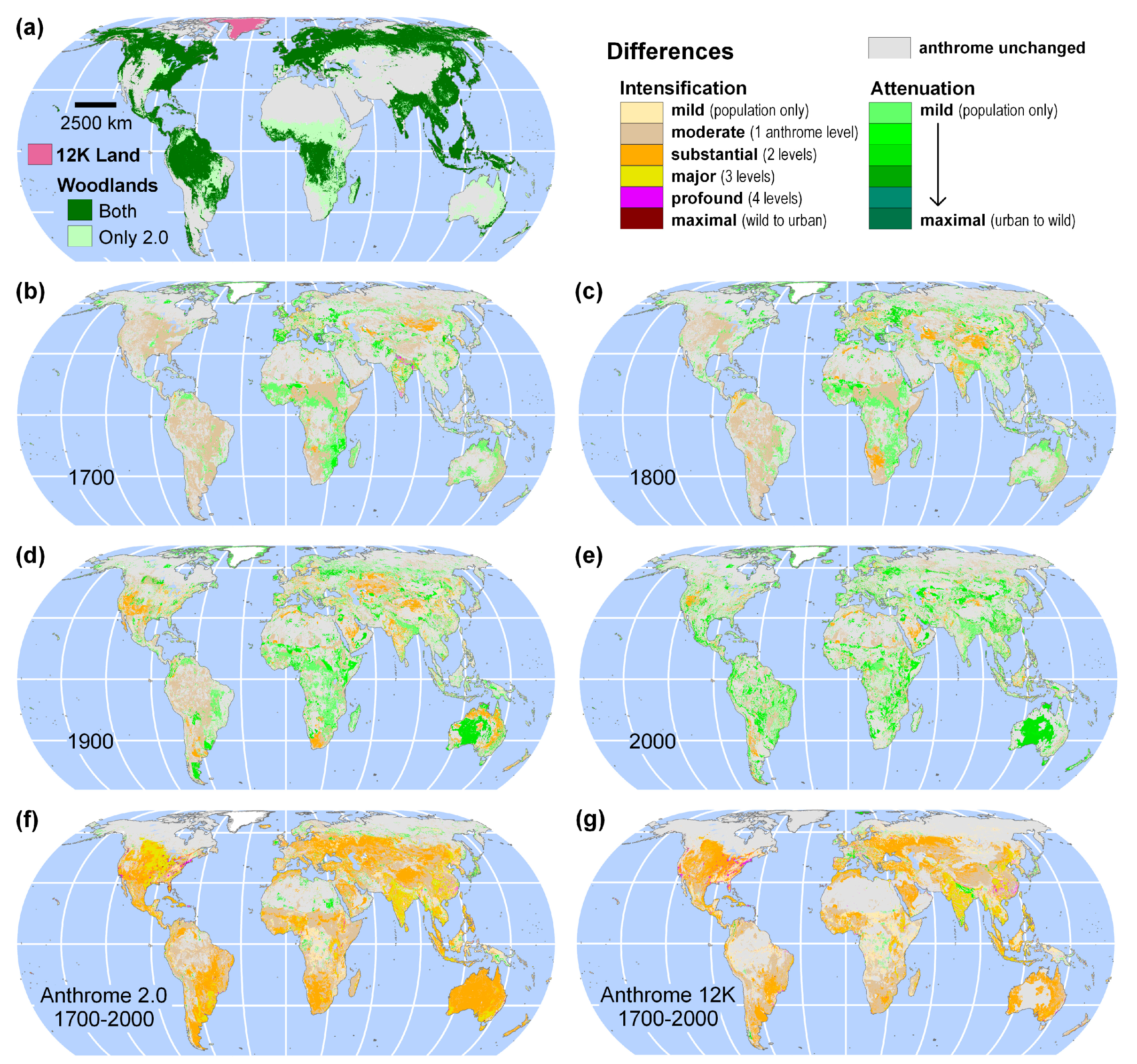
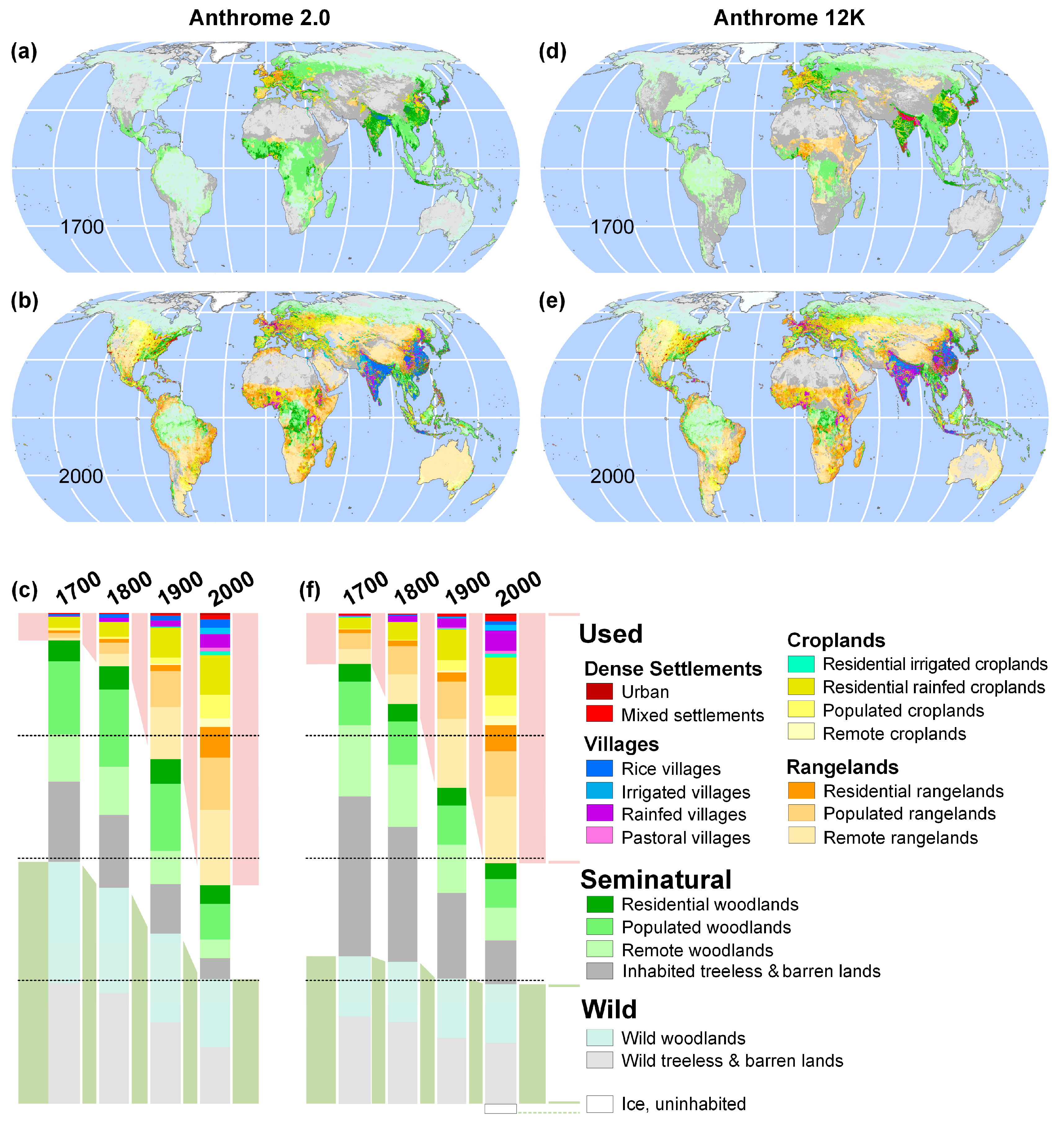
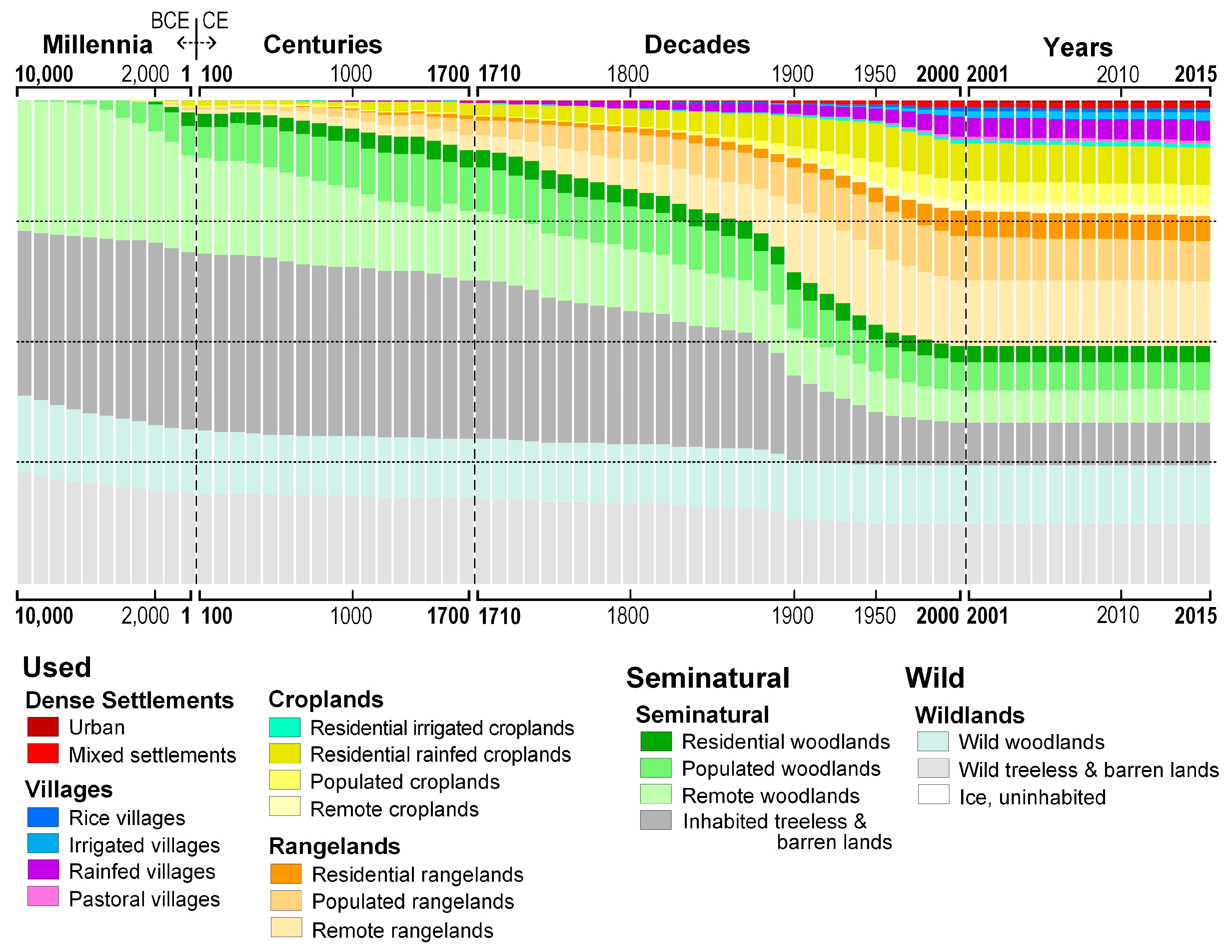
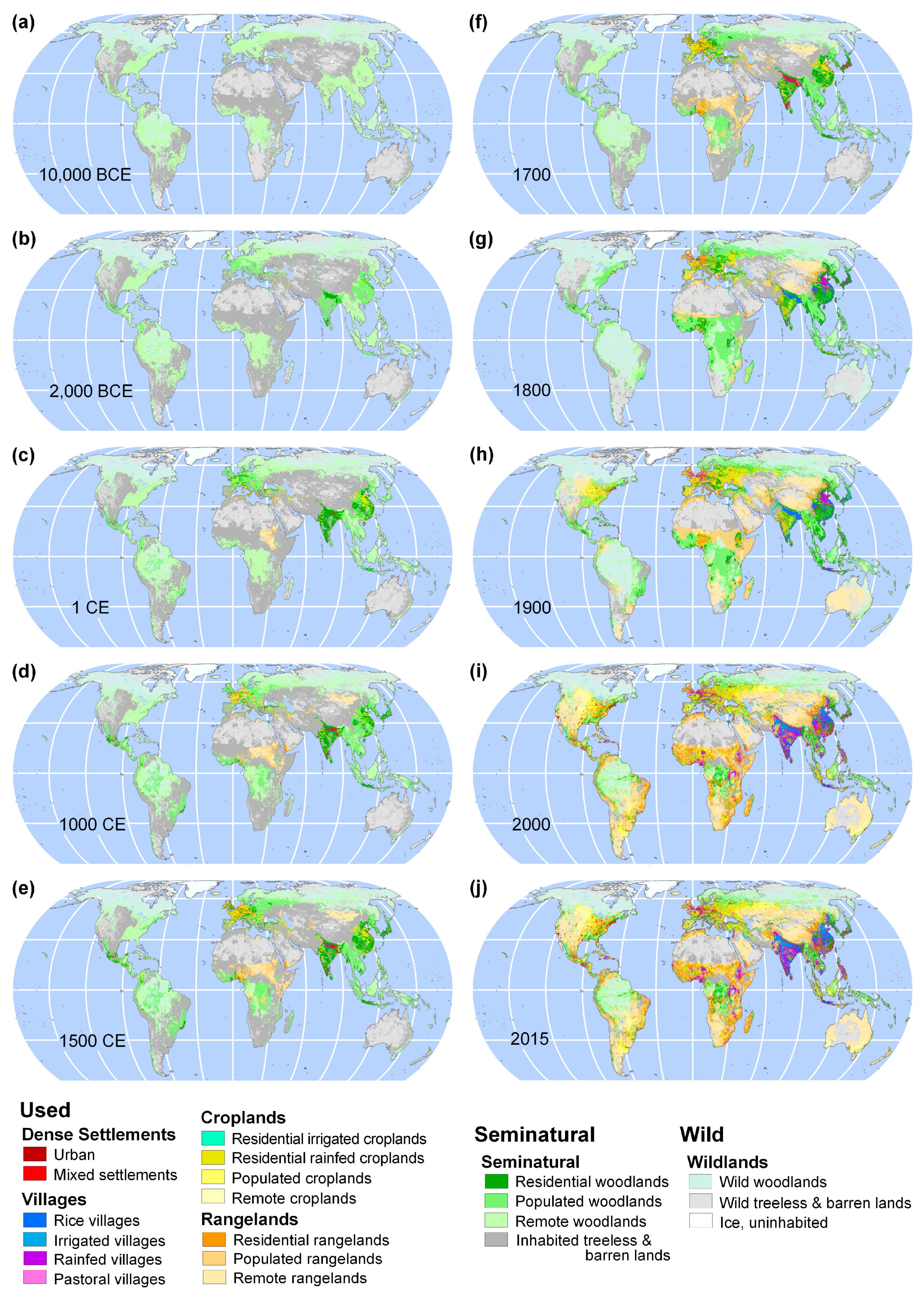
| Code | Name | Description |
|---|---|---|
| Dense settlements: Urban and other nonagricultural dense settlements | ||
| 11 | Urban | Densely built-up environments with very high populations |
| 12 | Mixed settlements | Suburbs, towns and rural settlements with high but fragmented populations |
| Villages: Densely populated agricultural settlements | ||
| 21 | Rice villages | Villages characterized by paddy rice |
| 22 | Irrigated villages | Villages characterized by irrigated crops |
| 23 | Rainfed villages | Villages characterized by rainfed agriculture |
| 24 | Pastoral villages | Villages characterized by pasture and rangeland |
| Croplands: Lands used mainly for annual crops | ||
| 31 | Residential irrigated croplands | Irrigated croplands with substantial human populations |
| 32 | Residential rainfed croplands | Rainfed croplands with substantial human populations |
| 33 | Populated rainfed croplands | Croplands with significant human populations |
| 34 | Remote croplands | Croplands without significant populations (irrigated and rainfed) |
| Rangelands: Lands used for pasture and livestock grazing | ||
| 41 | Residential rangelands | Rangelands with substantial human populations |
| 42 | Populated rangelands | Rangelands with significant human populations |
| 43 | Remote rangelands | Rangelands without significant human populations |
| Seminatural lands: Inhabited lands with minor use for permanent agriculture and settlements | ||
| 51 | Residential woodlands | Forest biome regions with minor land use and substantial populations |
| 52 | Populated woodlands | Forest biome regions with minor land use and significant populations |
| 53 | Remote woodlands | Forest biome regions with minor land use without significant populations |
| 54 | Inhabited treeless and barren lands | Regions without natural tree cover having only minor land use and a range of populations |
| Wildlands: Lands without human populations or substantial land use | ||
| 61 | Wild woodlands | Forests |
| 62 | Wild treeless and barren lands | Regions without natural tree cover (grasslands, shrublands, tundra, desert and barren lands) |
| 63 | Ice, uninhabited | Regions covered by permanent ice |
| Statistic | 1700 CE | 1800 CE | 1900 CE | 2000 CE |
|---|---|---|---|---|
| K | 0.519 | 0.516 | 0.518 | 0.573 |
| Klocation | 0.758 | 0.720 | 0.661 | 0.685 |
| Khistogram | 0.685 | 0.717 | 0.783 | 0.837 |
| Cramer’s V | 0.437 | 0.435 | 0.481 | 0.579 |
| Anthrome Level/Class | Anthromes 2.0 | Anthromes 12K | Difference |
|---|---|---|---|
| Dense settlements | 1,599,504 (1.25) | 1,944,387 (1.48) | 344,883 (0.26) |
| 11: Urban | 684,360 (0.53) | 571,287 (0.43) | 113,073 (−0.09) |
| 12: Mixed settlements | 915,144 (0.71) | 1,373,100 (1.04) | 457,956 (0.35) |
| Villages | 8,324,877 (6.49) | 8,573,609 (6.5) | 248,732 (0.19) |
| 21: Rice villages | 2,195,127 (1.71) | 926,154 (0.70) | −1,268,973 (−0.96) |
| 22: Irrigated villages | 1,733,295 (1.35) | 1,589,109 (1.21) | −144,186 (−0.11) |
| 23: Rainfed villages | 3,576,908 (2.79) | 5,331,507 (4.05) | 1,754,599 (1.33) |
| 24: Pastoral villages | 819,547 (0.64) | 726,839 (0.55) | −92,708 (−0.07) |
| Croplands | 19,950,484 (15.56) | 19,065,343 (14.46) | −885,141 (−0.67) |
| 31: Residential irrigated croplands | 1,090,155 (0.85) | 920,859 (0.70) | −169,296 (−0.13) |
| 32: Residential rainfed croplands | 10,307,863 (8.04) | 10,196,049 (7.74) | −111,814 (−0.08) |
| 33: Populated croplands | 6,037,937 (4.71) | 5,308,253 (4.03) | −729,684 (−0.55) |
| 34: Remote croplands | 2,514,529 (1.96) | 2,640,182 (2.00) | 125,653 (0.10) |
| Rangelands | 41,258,202 (32.19) | 36,224,142 (27.48) | −5,034,060 (−3.82) |
| 41: Residential rangelands | 7,908,903 (6.17) | 6,750,195 (5.12) | −1,158,708 (−0.88) |
| 42: Populated rangelands | 13,753,742 (10.73) | 11,747,394 (8.91) | −2,006,348 (−1.52) |
| 43: Remote rangelands | 19,595,557 (15.29) | 17,726,553 (13.45) | −1,869,004 (−1.42) |
| Seminatural | 24,673,582 (19.25) | 32,002,717 (24.28) | 7,329,135 (5.56) |
| 51: Residential woodlands | 4,896,997 (3.82) | 4,198,045 (3.19) | −698,952 (−0.53) |
| 52: Populated woodlands | 9,305,111 (7.26) | 7,673,846 (5.82) | −1,631,265 (−1.24) |
| 53: Remote woodlands | 5,008,400 (3.91) | 8,651,823 (6.56) | 3,643,423 (2.76) |
| 54: Inhabited treeless & barren lands | 5,463,074 (4.26) | 11,479,003 (8.71) | 6,015,929 (4.56) |
| Wildlands | 32,378,963 (25.26) | 33,993,839 (25.79) | 1,614,876 (1.23) |
| 61: Wild woodlands | 17,749,664 (13.85) | 15,463,788 (11.73) | −2,285,876 (−1.73) |
| 62: Wild treeless and barren lands | 14,629,299 (11.41) | 15,966,603 (12.11) | 1,337,304 (1.01) |
| 63: Ice, uninhabited | N/A | 2,563,448 (1.94) | 2,563,448 (1.94) |
| Global Total | 128,185,612 (100) | 131,804,039 (100) | 3,618,427 (2.70) |
| Woodland anthromes | 36,960,172 (28.83) | 35,987,502 (27.30) | −972,670 (−0.74) |
| Seminatural (total) | 19,210,508 (14.99) | 20,523,714 (15.57) | 1,313,206 (1.00) |
| Wild | 17,749,664 (13.85) | 15,463,788 (11.73) | −2,285,876 (−1.73) |
| Anthrome Level/Class | Anthromes 2.0 | Anthromes 12K | Difference |
|---|---|---|---|
| Dense settlements | 120,278 (0.09) | 405,905 (0.31) | 285,627 (0.22) |
| 11: Urban | 12,500 (0.01) | 647 (0.00) | −11,853 (−0.01) |
| 12: Mixed settlements | 107,778 (0.08) | 405,258 (0.31) | 297,480 (0.23) |
| Villages | 825,142 (0.64) | 407,562 (0.31) | −417,580 (−0.32) |
| 21: Rice villages | 469,884 (0.37) | 5,347 (0.00) | −464,537 (−0.35) |
| 22: Irrigated villages | 9,909 (0.01) | 8,162 (0.01) | −1,747 (−0.00) |
| 23: Rainfed villages | 341,669 (0.27) | 389,080 (0.3) | 47,411 (0.04) |
| 24: Pastoral villages | 3,680 (0.00) | 4,973 (0.00) | 1,293 (0.00) |
| Croplands | 3,504,812 (2.73) | 3,322,170 (2.52) | −182,642 (−0.14) |
| 31: Residential irrigated croplands | 12,867 (0.01) | 51,601 (0.04) | 38,734 (0.03) |
| 32: Residential rainfed croplands | 2,950,267 (2.3) | 3,034,634 (2.3) | 84,367 (0.06) |
| 33: Populated croplands | 516,156 (0.40) | 225,068 (0.17) | −291,088 (−0.22) |
| 34: Remote croplands | 25,522 (0.02) | 10,867 (0.01) | −14,655 (−0.01) |
| Rangelands | 2,456,187 (1.92) | 9,054,786 (6.87) | 6,598,599 (5.01) |
| 41: Residential rangelands | 532,533 (0.42) | 1,086,628 (0.82) | 554,095 (0.42) |
| 42: Populated rangelands | 1,344,269 (1.05) | 4,090,112 (3.10) | 2,745,843 (2.08) |
| 43: Remote rangelands | 579,385 (0.45) | 3,878,046 (2.94) | 3,298,661 (2.50) |
| Seminatural | 58,083,704 (45.31) | 77,347,902 (58.68) | 19,264,198 (14.62) |
| 51: Residential woodlands | 5,668,564 (4.42) | 4,790,548 (3.63) | −878,016 (−0.67) |
| 52: Populated woodlands | 19,072,793 (14.88) | 11,453,087 (8.69) | −7,619,706 (−5.78) |
| 53: Remote woodlands | 12,396,319 (9.67) | 18,670,521 (14.17) | 6,274,202 (4.76) |
| 54: Inhabited treeless & barren lands | 20,946,028 (16.34) | 42,433,746 (32.19) | 21,487,718 (16.30) |
| Wildlands | 63,195,489 (49.3) | 41,265,715 (31.31) | −21,929,774 (−16.64) |
| 61: Wild woodlands | 31,837,149 (24.84) | 15,925,413 (12.08) | −15,911,736 (−12.07) |
| 62: Wild treeless and barren lands | 31,358,340 (24.46) | 22,690,586 (17.22) | −8,667,754 (−6.58) |
| 63: Ice, uninhabited | N/A | 2,649,716 (2.01) | 2,649,716 (2.01) |
| Global Total | 128,185,612 (100) | 131,804,039 (100) | 3,618,427 (2.7) |
| Woodland anthromes | 68,974,825 (53.81) | 50,839,569 (38.57) | −18,135,256 (−13.76) |
| Seminatural (total) | 37,137,676 (28.97) | 34,914,156 (26.49) | −2,223,520 (−1.69) |
| Wild | 31,837,149 (24.84) | 15,925,413 (12.08) | −15,911,736 (−12.07) |
© 2020 by the authors. Licensee MDPI, Basel, Switzerland. This article is an open access article distributed under the terms and conditions of the Creative Commons Attribution (CC BY) license (http://creativecommons.org/licenses/by/4.0/).
Share and Cite
Ellis, E.C.; Beusen, A.H.W.; Goldewijk, K.K. Anthropogenic Biomes: 10,000 BCE to 2015 CE. Land 2020, 9, 129. https://doi.org/10.3390/land9050129
Ellis EC, Beusen AHW, Goldewijk KK. Anthropogenic Biomes: 10,000 BCE to 2015 CE. Land. 2020; 9(5):129. https://doi.org/10.3390/land9050129
Chicago/Turabian StyleEllis, Erle C., Arthur H.W. Beusen, and Kees Klein Goldewijk. 2020. "Anthropogenic Biomes: 10,000 BCE to 2015 CE" Land 9, no. 5: 129. https://doi.org/10.3390/land9050129
APA StyleEllis, E. C., Beusen, A. H. W., & Goldewijk, K. K. (2020). Anthropogenic Biomes: 10,000 BCE to 2015 CE. Land, 9(5), 129. https://doi.org/10.3390/land9050129






